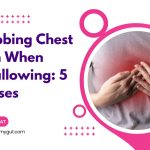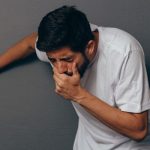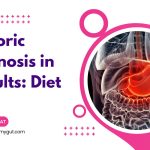4 Main Causes of Chest Pain After Eating Chocolate.
Our content is not intended nor recommended as a substitute for medical advice by your doctor. Use for informational purposes only.
Esophageal diseases are the most common cause of chest pain after eating chocolates (mainly GERD and hiatal hernia). Other causes may include heart attacks, IBS, functional dyspepsia, functional chest pain, etc.
In this article, you learn how to suspect each of the causes of chest pain after eating chocolate.
1. GERD (chronic acid reflux).
Gastroesophageal reflux disease (GERD), or chronic acid reflux, is one of the commonest diseases in the western world. Up to 20% (one in every five persons) suffer from GERD (reference).
GERD is the most likely cause of chest pain after eating chocolate or other foods such as fatty and spicy food.
It is often caused by a dysfunction in the junction between the esophagus and your stomach (the gastroesophageal sphincter).
The failure of this sphincter leads to the reflux of stomach acid and other contents into the esophagus (found in the chest).
With GERD, you may experience chest pain eating chocolate in the form of a burning sensation behind the breastbone.
Triggers of GERD:
- Caffeine in coffee, caffeinated drinks, and chocolates (especially dark chocolate).
- Fat in fatty and fried meals.
- Smoking.
- Large meals.
- Too many carbonated drinks.
- Potato chips and other processed snacks.
- Carbonated drinks.
- Citrus fruits, such as lemons, oranges, and orange juice.
- Spicy food such as pepper, garlic, raw onions, etc.
- Tomatoes and tomato sauce.
- Eating before bedtime.
- Lying flat in bed without head elevation.
- Psychological stress.
- Some medications include aspirin, ibuprofen (Advil®), naproxen, narcotics, OCPs, and theophylline. , etc.
Symptoms of GERD (acid reflux).
- Heartburn or burning chest pain is the most common symptom of acid reflux. Heartburn is burning pain in the chest behind the breastbone.
- The pain is often triggered by eating, such as after fatty meals or chocolate.
- Regurgitation: of food or acidic content into the throat or the mouth.
- Chocking attacks at night.
- Cough or phlegm after eating.
- Difficulty swallowing (not common).
- Sore throat.
- Shortness of breath after eating.
- Bad mouth odor, dental erosions.
Diagnosis & treatment of GERD.
Your doctor diagnoses GERD based on its characteristic symptoms (burning chest pain after eating and regurgitation). To confirm the diagnosis, an upper gastrointestinal endoscopy is often needed.
Main treatments of GERD (reference):
- Avoid trigger foods (including chocolates).
- Eat smaller, more frequent meals instead of fewer large meals.
- Head elevation during sleep.
- Avoid eating or drinking 2-3 hours before bedtime.
- Lose weight if you are obese (very effective treatment).
- Antacids (such as Tums®).
- Proton pump inhibitors such as omeprazole (Prilosec®) or Esomeprazole (Nexium®).
- H2 blockers such as Famotidine.
- Resistant cases may need endoscopic or surgical interventions.
2. Hiatal Hernia.
Hiatal hernia is the bulging of the upper part of the stomach into the chest through the diaphragm.
Hiatal hernia is considered one of the causes of GERD (acid reflux). However, it may also have weird symptoms, such as chest pain (not a typical burning sensation), hiccoughs, etc.
The hiatal hernia symptoms are typically the same as GERD symptoms, including:
- Heartburn.
- Non-heartburn chest pain may start after eating (chocolates or other trigger foods).
- Regurgitation of food particles or stomach acid (bitter fluid) into the throat or mouth.
- Fullness after eating.
- Dysphagia (difficulty swaloign).
- Cough, asthma, or phlegm after eating.
- Chocking attacks.
- Vomiting (which can be more prominent with hiatal hernia).
- Bad mouth odor.
- Bleeding may also occur (vomiting or blood or passing black stools).
Diagnosis and treatment:
The gold standard for diagnosis of hiatus hernias is often upper gastrointestinal endoscopy. People with recurrent chest pain or burning after eating often need an endoscopy to diagnose the cause, such as GERD and hiatal hernia.
Also, Imaging studies may help the diagnosis:
- Contrast study (X-ray with barium swallow).
- CT scan.
- Magnetic resonance imaging (MRI).
For mild cases of hiatal hernia, your doctor will prescribe medical treatments with proton pump inhibitors, antacids, and prokinetic drugs.
Surgery (laparoscopic fundoplication) or endoscopic correction may be needed for severe or resistant cases.
3. Other esophageal diseases.
- Achalasia: achalasia is the failure of the lower esophageal sphincter (at the junction between your esophagus and stomach) to relax. As a result, you may find it difficult to swallow foods or drinks. Chest pain after eating, vomiting, or undigested food is also common. Learn More.
- Eosinophilic esophagitis: It is a form of allergy affecting the esophageal lining. It causes inflammation of the esophagus after eating certain trigger foods (such as chocolates). The symptoms are often similar to GERD (burning chest pain, difficulty swallowing, vomiting, etc.). [Learn More.](https://www.hopkinsmedicine.org/health/conditions-and-diseases/eosinophilic-esophagitis#:~:text=Eosinophilic esophagitis is an allergic,in reaction to an allergen.)
- Esophageal cancer: Esophageal cancer affects one in every 125 men and one in every 417 women (reference)). The most common symptoms of esophageal cancer are progressive dysphagia (trouble swallowing), weight loss, and chest pain after eating. Learn More.
- Infectious esophagitis: infections of the esophagus affects mainly people with impaired immunity or severely debilitated elderly. The most common esophageal infection is candidiasis (infection by candida Albicans fungi).
- Pill esophagitis: Some pills may get stuck inside the esophagus, leading to severe chest pain. The most common pills to cause pill esophagitides are nonsteroidal anti-inflammatory drugs and some antibiotics.
- Esophageal stricture: Esophageal narrowing is usually due to either cancer or inflammation. The narrowed esophagus may cause trouble swallowing and chest pain after eating. [Learn More](https://my.clevelandclinic.org/health/diseases/21456-esophageal-strictures#:~:text=An esophageal stricture is an abnormal tightening or narrowing of,to travel down the tube.).
4. Heart attack (Anginal pain).
Heart attacks are the most serious cause of chest pain. However, chest pain due to heart attack is often associated with physical and mental stress. Heart attacks rarely occur after eating.
Although rare, you should be aware of this condition if you get unexplained chest pain after eating chocolate.
Heart attack chest pain has some unique characteristics that differentiate it from other types of chest pain.
So, Consider heart attack as a cause of your chest pain if:
- You have risk factors for coronary heart disease (heart attacks).
- You have the characteristic features of heart attack pain.
Risk factors:
- Being older (especially over 50 years).
- Being male.
- Personal history of prior heart attacks.
- Family history of coronary heart disease.
- Smoking.
- High blood pressure (hypertension).
- Diabetes Mellitus.
- High cholesterol.
- Being overweight.
- Sedentary lifestyle.
- Chronic stress.
- Unhealthy diet (high fat and high sugar diet).
- Alcoholism.
- Chronic kidney diseases.
Symptoms:
You should suspect acute coronary syndrome (heart attack) as a cause of chest pain after eating if you have (reference):
- Typical risk factors for acute coronary syndrome (the higher the number of risk factors, the more you should suspect a heart attack).
- Chest pain location: chest pain is often in the center of the chest (behind the breastbone) or diffuses all over the chest.
- Radiation: the pain often radiates to the top of the left shoulder and the left arm. It also may radiate to the neck, lower jaw, and teeth.
- Onset: the pain onset is gradual, starting after physical stress (such as climbing stairs), mental stress, or even after eating.
- Duration: the anginal pain is often short-lived, lasting from about two to five minutes. However, in severe cases (with myocardial infarction), the pain often lasts more than 30 minutes).
- The pain is usually in the form of intense squeezing, tightness, pressure, construction, crushing, or burning chest pain.
- Associated symptoms include shortness of breath (dyspnea), palpitations, sweating, nausea, or vomiting.
5. Other causes
- IBS: Patients with irritable bowel syndrome may have atypical symptoms, including chest pain after eating food (including chocolate). Learn more.
- Gallbladder diseases: Gallbladder stones may trigger right upper abdominal pain and chest pain after eating. Learn More.
- Functional chest pain.
- Functional dyspepsia.
- A food allergy or intolerance.
When to worry:
See a doctor if you have any of the following:
- Compressing or squeezing chest pain.
- Palpitation (uncomfortable awareness of heartbeats).
- Chest pain related to exertion or stress.
- Difficulty swallowing chocolate.
- Presence of anemia (iron deficiency anemia.
- Progressive weight loss in the past weeks or months.
- Painful swallowing of chocolate (odynophagia).
- Recurrent or persistent vomiting.
- Severe persistent anorexia (loss of appetite).
- Black stools or vomiting of blood.
- New onset chest pain after eating chocolates in ages older than 60.
- Evidence-based
- Written by a doctor.

Related Posts:
- Stabbing Chest Pain When Swallowing: 5 Causes,…
- Phlegm After Eating: 7 Causes & How to…
- 5 Main causes of abdominal pain and blood in the urine
- Can You Die from Eating Melon with Honey? A Doctor’s Answer.
- Stomach Pain at Night and Early Morning: 6 Causes,…
- Fatty Liver Pain: Causes, Mimics, and Treatment;…






